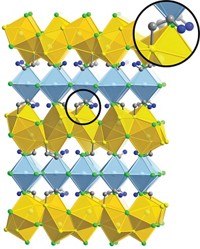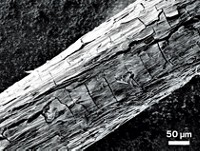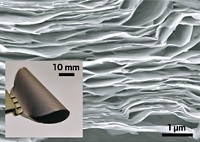Advertisement
Grab your lab coat. Let's get started
Welcome!
Welcome!
Create an account below to get 6 C&EN articles per month, receive newsletters and more - all free.
It seems this is your first time logging in online. Please enter the following information to continue.
As an ACS member you automatically get access to this site. All we need is few more details to create your reading experience.
Not you? Sign in with a different account.
Not you? Sign in with a different account.
ERROR 1
ERROR 1
ERROR 2
ERROR 2
ERROR 2
ERROR 2
ERROR 2
Password and Confirm password must match.
If you have an ACS member number, please enter it here so we can link this account to your membership. (optional)
ERROR 2
ACS values your privacy. By submitting your information, you are gaining access to C&EN and subscribing to our weekly newsletter. We use the information you provide to make your reading experience better, and we will never sell your data to third party members.
Materials
Squid Proteins Conduct Protons
Reflectin proteins transport protons as well as state-of-the-art artificial proton conductors
by Bethany Halford
June 2, 2014
| A version of this story appeared in
Volume 92, Issue 22
Proteins found in the skin of cephalopods may be promising materials for next-generation bioelectronics. Squid, cuttlefish, and their cephalopod kin use proteins known as reflectins to alter their appearance for camouflage. Researchers now report that thin films made of reflectin from the longfin inshore squid, Doryteuthis pealeii, possess proton-conducting properties on par with state-of-the-art artificial proton conductors and could therefore make it possible to use them in protonic transistors (Nat. Chem. 2014, DOI: 10.1038/nchem.1960). “Given the importance of protons for electrical signaling in biology, protonic transistors represent a natural choice for interfacing rugged traditional electronics and biological systems that are decidedly more fragile,” notes the research team, led by Alon A. Gorodetsky of the University of California, Irvine. Gorodetsky and coworkers point out that reflectin has a unique amino acid sequence, which contains a significant number of hydrophilic charged residues as well as a large number of hydrophobic aromatic residues. This sequence, they say, makes reflectin amphiphilic, causing it to aggregate into nanoparticles both in solution and in thin films. The researchers speculate that the films are segregated into distinct hydrophobic regions and proton-conducting hydrophilic water channels—a structure that’s analogous to that of DuPont’s proton-conducting sulfonated fluoropolymer Nafion.





Join the conversation
Contact the reporter
Submit a Letter to the Editor for publication
Engage with us on Twitter